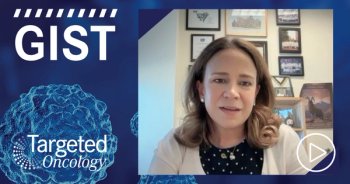
Case 1: 66-Year-Old Woman With GIST
The experts discuss a case presentation of a 66-year-old woman with heavily pretreated GIST, and comment on follow-up times and treatment options.
Episodes in this series

Margaret von Mehren, MD: Thank you for joining us for this Targeted Oncology™ Virtual Tumor Board®, which is focused on GIST [gastrointestinal stromal tumor]. In today’s presentation, my colleagues and I will review 3 clinical cases. We will discuss an individualized approach to treatment for each patient, and we’ll review key clinical trial data that affect our decisions.
I am Margaret von Mehren from Fox Chase Cancer Center in Philadelphia, Pennsylvania. I’m joined by Dr Mark Agulnik from City of Hope in Duarte, California; Dr Rich Riedel from Duke University [School of Medicine] in Durham, North Carolina; and Dr Jason Sicklick from Moores Cancer Center at UC San Diego Health in La Jolla, California. I’m going to turn it over to Dr Agulnik to start with our first case.
Mark Agulnik, MD: Thank you. I appreciate it and the opportunity to be discussing this with all of you. The first case we’re going to talk about is a patient who is very typical of what we see in our clinic, and that is what we would call a heavily pretreated GIST.
The patient is a 66-year-old woman who has a complaint of a 4-month history of early satiety and a vague abdominal pain. On physical exam, she’s found to have a left upper quadrant pain on deep palpation, but otherwise, it’s quite unremarkable. When we check her labs, on CBC [complete blood count] we have a hemoglobin count of 9.5 g/dL and a platelet count of 110,000 per mm3; all her other labs are within normal limits.
The patient undergoes endoscopy, which shows a submucosal 5.5-cm mass with ulceration, and on EUS [endosonography], she’s found to have irregular borders on extraluminal surfaces of the stomach with evidence of a heterogeneous echogenicity. Biopsy was then obtained.
What we see from the biopsy is that it is immunohistochemistry positive for CD117. She also has a pelvic and abdominal CT that confirms a 5.6-cm lesion in the antrum of the stomach, but she also has evidence of peritoneal metastases.
The tumor specimen that was biopsied was also sent for genetic mutational analysis, and the patient was found to have a KIT exon 11 mutation. As well, the patient has an ECOG performance status of 0.
As standard of care goes, the patient was started on imatinib 400 mg once a day for her metastatic GIST. She was able to be maintained on this dosage schedule. She was monitored for disease progression and toxicities every 3 months and just shy of 2 years at the 22-month mark, she complained of recurrent abdominal pain, unintended weight loss, and decreased appetite. At that point, she had more imaging done, which did show disease progression. At that point, imatinib was discontinued.
The patient then goes to a second-line therapy with sunitinib and is dosed at 37.5 mg. She tolerates this well with mild diarrhea. She stays on this treatment for 9 months until imaging shows at that point disease progression again.
We’re going to pause the case here and have a discussion to see what everyone else’s treatments would have been at that time. The first question to come out is, is everyone’s practice similar with respect to how we dose our imatinib and when we go to higher dosing of imatinib?
In my practice, what I would do for a patient like this is start them at 400 mg. Then I would double the dose to 800 mg if they are tolerating it and if there are signs of disease progression. What do you guys feel about that strategy?
Margaret von Mehren, MD: I oftentimes do that as a bridge, particularly if somebody is having a hard time with the idea of switching to another therapy. But I do look at the mutation, and so I am less likely to do it for somebody who has an exon 11 mutation, but I still do offer it. Rich, what do you do?
Richard Riedel, MD: I follow up similar to what Meg articulated. I’ll routinely dose escalate after standard dose of imatinib in the setting of progressive disease. I will inform the patients that for most individuals we will get stabilization, rather than a response with dose escalation, but I’ll often consider that prior to considering sunitinib just because imatinib is the most well-tolerated medication that we have in the setting of dose escalation. I still find that patients tolerate it very well, so I will consider standard dose, followed by dose escalation and then sunitinib.
Mark Agulnik, MD: Meg brought up an important point. It’s the concept of how the patient perceives their illness. When you get to 22 months of 1 therapy, you sort of can sit back, you lean into the illness, and it becomes a chronic disease for you. There are so many other diseases we treat, where we switch very quickly, like every 6 weeks for scanning, and you could have switches at that point.
I like how you call it the bridge to get them to realize that they need something else. Because inevitably as Rich and I keep them on the double dose, within a few months we’re switching in all likelihood anyway. But it really is getting them into this paradigm where they were stable for so long, and then all of a sudden they have to change the way they view their illness.
Margaret von Mehren, MD: Jason, are there any times when you think about taking these patients to the operating department?
Jason Sicklick, MD, FACS: That’s a great question. Yes. Actually, as I was hearing this case, certainly when patients have stable disease or responsive disease and in reviewing the imaging, if it’s clear that we can get complete cytoreduction, in that we can remove both the primary as well as the metastatic disease, I often see it being as a reasonable approach to consider taking them to the operating department and performing a resection. It’s much more ideal to do this in the setting of responsive disease over progressive disease in those kinds of scenarios.
Mark Agulnik, MD: Do you get a PET [positron emission tomography] scan before you take them to surgery? That’s typically been my previous practice, just to make sure that the disease is active. But I’m wondering what your approach would be.
Jason Sicklick, MD, FACS: I generally don’t use PET scans very often in the management. It comes down to anatomical factors obviously in terms of the resection of the primary tumor. Secondarily, whether it’s peritoneal disease vs liver disease or a combination of both, often with MRIs we can get a good sense of what the metastatic disease to the liver is. PET scan, CT, or MRI often underestimate the amount of peritoneal disease.
If we don’t see evidence of significant incremental caking or large-volume peritoneal-based disease, often we’ll find disease, but it’s small enough volume that we can cytoreduce that.
Richard Riedel, MD: In the setting of limited progression and then a resection of that progressive disease, what do individuals do with respect to the therapy? In this case, would you put them back on standard-dose imatinib or whatever the immediate prior therapy was? Would you change therapy? We’ll often get asked that question. I’m curious to know what you guys do in your practice.
Margaret von Mehren, MD: I typically keep them on what they were on before. If I had dose-escalated imatinib just to get them to surgery, I might put them back on standard-dose imatinib. If they’re able to be cytoreduced and resected, I don’t switch therapy at that time. I wait until there’s another progression event before doing that.
Mark Agulnik, MD: I do the same thing. The benefit of the surgery is it buys you time on the original treatment. By then, most people are tolerating it quite well.
Jason Sicklick, MD, FACS: That’s exactly what I do in my practice. Sometimes patients struggle with that and they’ll say, “Why are we staying on a therapy that clearly wasn’t working?” What I’ll try to explain to them is that we’ve actually in essence removed the problem child from the classroom, so to speak. We just go back and do what we were doing before.
Mark Agulnik, MD: When you guys counsel your patients, how do you tell them what you anticipate will happen with first- and second-line therapies? In my practice, I typically tell someone that I anticipate they could stay on first line for 18 to 24 months and get some durability with it. For second line, when I go there, I’m looking more at the 6- to 9-month range for our patients. What about you guys?
Margaret von Mehren, MD: It’s interesting. I typically talk about what I’m expecting in terms of their disease, whether I’m curing it or controlling it. Oftentimes I am less of a person who defines what the time frame is. Part of that is that I have a patient who started on imatinib in the year 2000 and continues on imatinib for metastatic disease. Maybe you’re correct from the clinical trials, the median time to progression is about 2 years on imatinib in all comers, but you have to look at each patient. Some of these patients can have very prolonged stabilization on imatinib. Unless specifically asked, I usually don’t provide a specific time frame.
Richard Riedel, MD: In my practice, I speak very much in generalities. I will mention that as we move to second, third, or even fourth line or beyond, oftentimes there can be diminishing returns, although admittedly I have patients who for whatever reason will progress through a first- and second-line therapy, only to have a long disease control in the third-line setting. It’s highly individualized and highly variable.
If someone asks, I’ll share with them what we’ve articulated about on average 2 years in the front line, 6 months second line, 4½ to 5 months third line, etc. But I’ll speak more in general terms if anything.
Mark Agulnik, MD: How are you guys typically following up and monitoring? I imagine you’re not getting scans every 3 months after 10 years or plus of imatinib? What is your typical monitoring? How are you doing it for these patients?
Margaret von Mehren, MD: In somebody like this who is progressing, they are sticking to that every 3 months, unless they show me that they can be stable for a prolonged period of time. For people who are on imatinib and have been on imatinib for a prolonged period of time, I tend to have scans 6 to 12 months apart. I’m a bit leery about going a year, so I usually compromise around 9 months. That’s more for me than for them.
Richard Riedel, MD: Meg, I share your philosophy. I have several patients who have had prolonged disease stability for years, but I’m still seeing them every 6 months. Rarely if ever do I go to a year. Admittedly, I have gone to a year recently in a patient who was rendered disease-free, although surgically, but had metastatic disease on a long-term therapy who is now 5 years out. There’s no evidence of visible disease on systemic therapy. In those situations, I will extend a little further. But it’s the rare patient in whom I will do that.
Transcript edited for clarity.













































